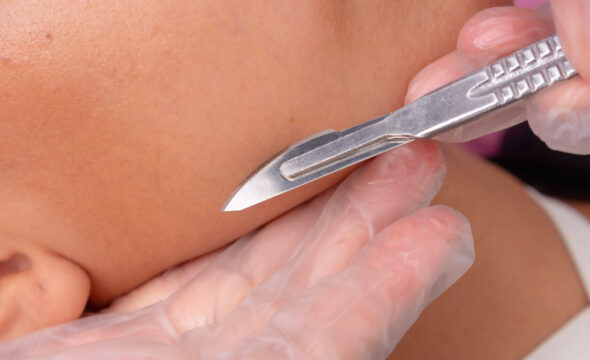How Often Should You Dermaplane
According to a study, nonsurgical cosmetic face treatments are booming in the U.S., earning about $16.5 billion annually. From 2000 to 2018, these procedures jumped by 228%. Among these treatments, many people are turning to ways that promise smoother, more radiant skin.
Among these, dermaplaning has emerged as a favorite for those looking to refine their skincare routine with noticeable improvements, and 4Ever Young in Marietta, GA, offers this popular treatment to help you achieve smoother, more radiant skin.
If you’re curious about how often you should use Dermaplane to boost your skincare routine, you’re in the right place. Whether you deal with acne-prone or mature skin, adjusting your approach can enhance your natural glow. This guide explores what dermaplaning can do for you and how to make it work in your skincare regimen.
What Is Dermaplaning?
In dermaplaning, skincare professionals use a special tool to carefully remove and scrape off the top layer of skin, consisting of dead cells and fine hair, often called peach fuzz. This process helps reveal the fresh skin underneath. It’s a straightforward method many people choose to maintain smooth and clear skin, enhancing the overall look of their complexion.
Who Is a Good Candidate for Dermaplaning?
Dermaplaning can be a great fit for many people. It is for:
- People With Dry or Uneven Skin Texture: Helps smooth and refresh the skin’s surface.
- Individuals With Sensitive Skin: Best performed by a trained aesthetician due to the delicate nature of your skin.
- Those With Acne-Prone Skin: Consult a professional first to ensure it’s suitable for you.
- Individuals With Mature Skin: Can help reveal a more youthful appearance without harsh treatments.
- People Looking for Smoother Makeup Application: Creates a perfect canvas for makeup.
- Those With Unwanted Hair: Great for removing fine vellus hair and enhancing your complexion.
- Individuals Not Currently Experiencing Active Acne: If you are suffering from active breakouts, other treatments, like chemical peels or laser hair removal, might be more effective.
Disclaimer: Always consult with a qualified skincare professional like those in 4Ever Young in Marietta, GA, before starting any new facial treatment to make sure it aligns with your skin conditions and concerns.
What to Expect During and After Dermaplaning
Before getting the answer to “How often should I dermaplane?” learning about the steps first is helpful. Dermaplaning is a straightforward process with noticeable benefits. Here’s a step-by-step look at what happens:
During the Session
- Preparation: To start, we gently cleanse your skin to remove oils or dirt, preparing it for an effective treatment.
- Scalpel Glide: A skilled professional carefully slides a special surgical scalpel across your face. This step removes both fine hairs (peach fuzz) and the outermost layer of skin made up of dead skin cells.
- Gentle Exfoliation: This process leaves your skin smooth, creating a fresh surface that’s ready for the next steps in your skincare routine.
After the Session
- Immediate Glow: You’ll see that your skin looks brighter and feels incredibly smooth to the touch right away.
- Skincare Absorption: Post-treatment, your skin is primed to absorb skincare products better, making them more effective.
- Minimal Downtime: Most people experience little to no irritation, so you can resume your day without any issues.
Dermaplaning: How Often Should It Be Done?
Dermaplaning is best done every 3-4 weeks. This interval allows your skin to naturally renew itself, helping maintain a smooth and fresh complexion.
Why This Frequency?
- Natural Renewal: Aligns with your skin’s natural shedding cycle, supporting its natural rhythm.
- Protects the Skin Barrier: Offers enough time between sessions to prevent irritation and maintain the protective barrier.
- Consistent Results: Guarantees smoothness and enhances the absorption of skincare products.
Factors That Influence the Frequency of Dermaplaning
Understanding how often to dermaplane depends on several factors unique to you. Here’s a breakdown of what to consider:
Skin Type
If you have oily skin, you might handle more frequent sessions since your skin can often recover quicker. However, if your skin is dry or sensitive, it’s important to space out treatments to avoid irritation. Each skin type responds differently, so adjust according to your comfort level.
Skincare Routine
Your skincare routine plays a big role. If you’re using regular chemical exfoliants, it’s wise to space out dermaplaning to prevent over-exfoliation. Post-session, focus on soothing and hydrating products to help your skin recover.
Specific Skin Concerns
Regular sessions help reduce the appearance of fine lines and wrinkles. However, if you’re using acne medication or have certain skin conditions, consult a professional to ensure it complements your treatment without causing issues.
Professional Advice
Consulting with a skin care professional is always beneficial, especially if you have sensitive areas or specific concerns. They can give personalized advice to ensure that dermaplaning fits your skin’s needs.
Lifestyle and Environment
Frequent sun exposure or certain daily activities affect how often you should dermaplane. Depending on your lifestyle and environment, you might need a schedule that matches your daily routine and skin exposure.
Benefits and Risks of Dermaplaning
Dermaplaning offers several advantages, but it’s important to be aware of potential risks. Here’s a detailed look at what dermaplaning can achieve and what you should watch out for:
| Benefits | Risks |
| Enhanced Skin Rejuvenation: Regular treatments help remove dead skin cells, exposing a fresher layer of skin and encouraging a youthful glow. | Skin Irritation: If performed incorrectly, it can cause redness and sensitivity. |
| Natural Glow: By exfoliating the top layer, your skin appears more radiant and smooth. | Damage to Skin Barrier: Overdoing it may weaken the skin’s natural protection. |
| Improvement in Fine Lines: Helps soften the appearance of fine lines, giving a smoother look. | Risk of Infection: Using non-sterile tools can lead to skin infections. |
| Better Absorption of Skincare Products: Removes barriers that might impede product effectiveness. | Not Suitable for All Skin Types: Those with active acne or very sensitive skin might need to avoid it. |
| Smooth Makeup Application: Clearer skin texture helps makeup go on evenly and last longer. | Temporary Redness: Some may experience short-lived redness post-treatment. |
Grasping both the benefits and risks enables you to decide wisely about adding dermaplaning to your skincare routine. Consulting a professional ensures you reduce risks and boost benefits tailored to your skin type.
What to Do Following Dermaplaning
After a dermaplaning session, your skin is fresh and smooth. Here’s how to care for your freshly exfoliated skin to maintain that youthful glow:
- Hydration: Use a gentle, hydrating moisturizer to keep your skin supple and nourished. Drinking water also supports hydration from within, helping your skin stay healthy and radiant.
- Sun Protection: Use a sunscreen that is broad-spectrum and with at least SPF 30 to protect against UV rays, and try to steer clear of direct sun exposure, especially immediately following the treatment.
- Avoid Active Ingredients: To prevent irritation, avoid chemical exfoliants or active ingredients like retinol for a few days. Instead, focus on soothing and gentle products that won’t disrupt your skin barrier.
- Use Rejuvenating Skincare Products: To promote skin recovery, opt for products rich in antioxidants and healing properties. Consider serums with hyaluronic acid to lock in moisture and enhance your skin’s glow.
Frequently Asked Questions
Dermaplaning is a popular treatment, but you might have some questions about it. Here are answers to the most common queries:
Is Dermaplaning Painful?
Generally, dermaplaning is painless. Most people describe it as feeling like gentle scratching or a soft brushing on the skin. It’s a comfortable process that many find soothing, making it a stress-free addition to your skincare routine.
Can Anyone Perform Dermaplaning at Home?
While you can try dermaplaning at home, seeking professional guidance is recommended for safer and more effective outcomes. Professionals are skilled in using the tools properly and can adjust the treatment to your skin type and needs. This minimizes risks such as irritation or uneven results, making sure of a smooth and satisfying experience. At 4Ever Young in Marietta, GA, experts provide tailored dermaplaning treatments for optimal results.
What Time Is Best to Dermaplane?
Many people choose to have their dermaplaning sessions in the evening. This timing allows your skin to rejuvenate overnight, fitting perfectly with your nighttime skincare routine. After the treatment, your skin will be more receptive to absorbing nourishing products while you sleep, enhancing the overall benefits.
Get Your Glow: Book a Consultation With Us Today!
Are you ready for a natural glow and smoother, radiant skin? At 4Ever Young in Marietta, GA, we’re here to guide you. Our experts will design a personalized plan to fit your unique skincare needs. Whether you’re aiming to refresh your look or maintain healthy skin, we offer professional treatments that can enhance your appearance.
Feel free to reach out and discover the rejuvenating benefits our services offer. Contact us today to schedule your consultation—let’s get you glowing!
📍 Visit us at 4Ever Young Marietta
📞 Call (470) 740-6847
💻 Book your complimentary consultation today
✨ 4Ever Energized. 4Ever Strong. 4Ever You.







